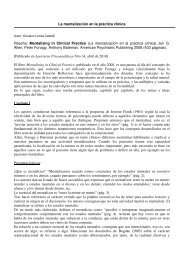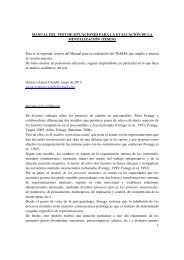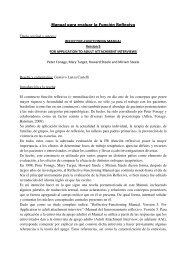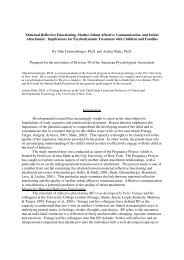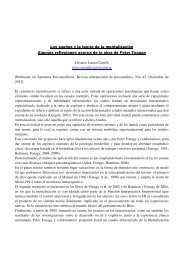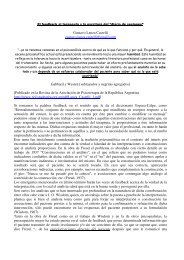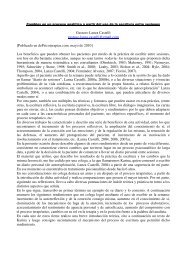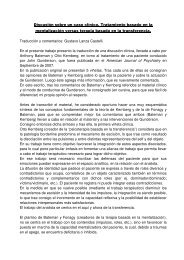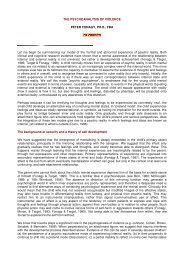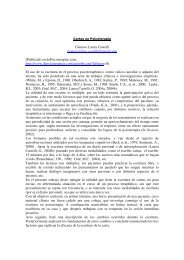Mentalizing, motivation, and social mentalities: Theoretical ...
Mentalizing, motivation, and social mentalities: Theoretical ...
Mentalizing, motivation, and social mentalities: Theoretical ...
Create successful ePaper yourself
Turn your PDF publications into a flip-book with our unique Google optimized e-Paper software.
Psychology <strong>and</strong> Psychotherapy: Theory, Research <strong>and</strong> Practice (2011), 84, 9–25<br />
C○ 2010 The British Psychological Society<br />
9<br />
The<br />
British<br />
Psychological<br />
Society<br />
www.wileyonlinelibrary.com<br />
<strong>Mentalizing</strong>, <strong>motivation</strong>, <strong>and</strong> <strong>social</strong> <strong>mentalities</strong>:<br />
<strong>Theoretical</strong> considerations <strong>and</strong> implications<br />
for psychotherapy<br />
Giovanni Liotti 1 <strong>and</strong> Paul Gilbert 2∗<br />
1 APC School of Psychotherapy, Roma, Italy<br />
2 Mental Health Research Unit, Kingsway Hospital, Derby, UK<br />
Background. Mentalization has recently been identified as a major process in the<br />
origins, maintenance, <strong>and</strong> recovery from various mental disorders.<br />
Aims. Questions arise however, as to the degree to which deficits in mentalization<br />
can be trait or state-like: whether they manifest themselves across all types of human<br />
interaction, or are they relationship dependent, such that different types of relationship<br />
(e.g., affiliative vs. competitive) can facilitate or compromise mentalizing?<br />
Findings. This paper suggests that mentalization has a complex evolutionary history,<br />
has various subtypes <strong>and</strong> functions, is highly regulated by the experience of threat or<br />
safeness within relationships, <strong>and</strong> can operate differently in different types of <strong>social</strong><br />
relationship.<br />
Implications. Awareness of this enables therapists to pay particular attention to<br />
the <strong>social</strong> roles <strong>and</strong> types of relationships in which mentalization occurs, its specific<br />
focus <strong>and</strong> functions for specific types of relationships. Therapists can be mindful of the<br />
kind of specific events in <strong>social</strong> roles that activate threat <strong>and</strong> loss of mentalizing (e.g.,<br />
ab<strong>and</strong>onment threats, feeling controlled by ‘the other’, status loss, non-reciprocation).<br />
In the wake of the 200th anniversary of Darwin’s birth, it is useful to reflect on how<br />
profoundly the publication of On The Origin of Species in 1859 transformed our thinking<br />
about the nature of our minds. We now know that human minds are products of<br />
evolution, designed to carry forward a range of <strong>motivation</strong>s for achieving specific<br />
<strong>social</strong> goals <strong>and</strong> forming particular types of relationship, including care seeking-care<br />
giving (attachment), competition for resources <strong>and</strong> forming <strong>social</strong> ranks (dominance–<br />
submission), alliance building <strong>and</strong> cooperation, <strong>and</strong> sexual pair-bonding (Buss, 2003;<br />
Gilbert, 1989). Evolutionary thinking has also focused on the profoundly human<br />
psychological competencies, labelled in various ways, such as, theory of mind, metacognition,<br />
empathy, <strong>and</strong> mentalization, that stem from, <strong>and</strong> are deeply embedded within,<br />
recent human <strong>social</strong> evolution (Byrne, 1995; Choi-Kain & Gunderson, 2008; Hrdy, 2009;<br />
∗ Correspondence should be addressed to Professor Paul Gilbert, Mental Health Research Unit, Kingsway Hospital, Derby<br />
DE22 3LZ, UK (e-mail: p.gilbert@derby.ac.uk).<br />
DOI:10.1348/147608310X520094
10 Giovanni Liotti <strong>and</strong> Paul Gilbert<br />
Whiten, 2000). In this paper, we use the wide-ranging term ‘mentalization’ to refer<br />
collectively to all the higher order competencies that enable humans to infer <strong>and</strong> think<br />
about the mental states of self <strong>and</strong> others. Although these do represent a family of<br />
different overlapping processes that require more fine grained definition <strong>and</strong> research,<br />
it is well known that helping people to st<strong>and</strong> back from their immediate reactions, to<br />
think about the intentions <strong>and</strong> processes in the minds of others, <strong>and</strong> in their own minds,<br />
is a very important focus for many therapies (Bateman & Fonagy, 2004; Choi-Kain &<br />
Gunderson, 2008; Dimaggio & Lysaker, 2010).<br />
Different hypotheses have been advanced regarding the influence of different <strong>social</strong><br />
<strong>motivation</strong>al systems (e.g., for attachment, or competitive behaviour) both in the<br />
evolution of mentalization <strong>and</strong> in its exercise during individual development. One of<br />
these hypotheses suggests that the evolution of mammalian attachment is the main<br />
<strong>motivation</strong>al system that underpinned the evolution of mentalization (Fonagy, Gergely,<br />
Jurist, & Target, 2002). However, quoting recent brain imaging studies, Fonagy <strong>and</strong><br />
his collaborators acknowledged that the activation of brain areas mediating attachment<br />
behaviour actually inhibit brain areas mediating mentalization (Fonagy & Luyton, 2009;<br />
Fonagy & Target, 2009). As it will be argued in a later section of this paper, it is possible<br />
that the activation of the attachment system, in the face of threats, inhibits mentalizing<br />
abilities because the evolutionarily older threat-defence (fight–flight) system, that is also<br />
active in such circumstances, normally inhibits higher order cognitive processes (see<br />
below). In contrast, feeling safe because of the protective availability of an attachment<br />
figure, who is perceived as capable to protecting against the danger <strong>and</strong> signals low<br />
threat, may foster mentalization. These considerations suggest that attachment per se is<br />
not the only evolutionary underpinning of mentalization: rather, attachment processes<br />
may allow for the recovery of mentalization, in the presence of danger, through the<br />
contact with an attachment figure that is able to provide help <strong>and</strong> guidance <strong>and</strong> activates<br />
a renewed sense of safeness <strong>and</strong> soothing.<br />
Whatever might be the role of the attachment system in the evolution of mentalizing<br />
abilities, it is possible that a range of <strong>social</strong> roles (e.g., alliance building) that create<br />
feelings of safeness, may have facilitated the evolution of mentalization. For example,<br />
Alex<strong>and</strong>er (1989), Gergely <strong>and</strong> Unoka (2008), <strong>and</strong> Humphrey (1976), see a role for<br />
mentalization in successful competition for <strong>social</strong> rank. Chimpanzees, for example, have<br />
a degree of self-awareness <strong>and</strong> mentalizing ability enabling them to underst<strong>and</strong> the impact<br />
of their <strong>social</strong> signals on others – <strong>and</strong> conceal them. Cheney, Seyfarth, <strong>and</strong> Smuts (1986)<br />
offer an interesting example:<br />
In a captive group of chimpanzees two adult males Nicki <strong>and</strong> Luit were engaged in a<br />
prolonged struggle for dominance. During one fight Nicki was driven into a tree. As Luit sat<br />
at the bottom of the tree, he nervously ‘fear grinned’. He then turned away from Nicki, put<br />
a h<strong>and</strong> over his mouth <strong>and</strong> pressed his lips together to hide a sign of submission. Only after<br />
the third attempt when Luit succeeded in wiping the grin from his face did he once again<br />
turn to face Nicki. (p. 1364).<br />
This example shows how some forms of mentalization can be useful in conflictual <strong>and</strong><br />
competitive situations <strong>and</strong> enable perceptions <strong>and</strong> displays of things like deception,<br />
bluffing, <strong>and</strong> awareness of intent. Other theorists focus on alliance building <strong>and</strong><br />
cooperativeness (Moll & Tomasello, 2007) or abilities to relate to multiple caregivers<br />
(Hrdy, 2009) to account for the socio-<strong>motivation</strong>al underpinnings of mentalization.<br />
So the evolution of mentalization in human phylogeny may be developed through<br />
different types of <strong>social</strong> relating, <strong>and</strong> in turn influence a range of <strong>social</strong> relationship
Mentalization 11<br />
forming abilities. If this is the case, then how different <strong>social</strong> <strong>motivation</strong>s <strong>and</strong> <strong>mentalities</strong><br />
influence mentalization is an important issue for psychotherapists interested in assessing<br />
<strong>and</strong> fostering a patient’s mentalizing capacity during clinical dialogues. In this paper, we<br />
will make three suggestions:<br />
• First, while the potential mechanisms that enable mentalization are innate, the<br />
ontogenetic development of mentalizing involves explorative behaviour, which<br />
flourishes most in conditions of open attention <strong>and</strong> <strong>social</strong> safeness. In the normal<br />
course of events feeling safe <strong>and</strong> open to explore (that is conducive to mentalization)<br />
flourishes in conditions created by affiliative relationships inside <strong>and</strong> outside the<br />
attachment context.<br />
• Second, while affiliative behaviour is usually associated with soothing <strong>and</strong> feeling safe<br />
with other people, for those from neglectful or abusive backgrounds these feelings<br />
can be threatening. If affiliative signals from others thus come to signal active threat,<br />
<strong>and</strong> threat processing closes down the open exploration of contents of one’s own<br />
<strong>and</strong> other people minds, then for some people ‘too much affiliation’ can rupture<br />
mentalization abilities.<br />
• Third, personality development creates individualized patterns of activity of different<br />
<strong>social</strong> <strong>motivation</strong>al systems that may involve mentalization deficits when a given<br />
<strong>motivation</strong>al system is active, but not when another <strong>motivation</strong>al system comes to<br />
govern interpersonal behaviour.<br />
Threat <strong>and</strong> safeness<br />
The distinction between threat <strong>and</strong> safeness is fundamental to all living things (Gilbert,<br />
1989, 2007). Pursuing any goal carries risks <strong>and</strong> threats as well as benefits. So, animals<br />
have to be able to process both the threat <strong>and</strong> potential value of pursuing the goal. The<br />
greater the value of the goal the more risks individuals may take to secure them. We<br />
know that the basic mammalian threat-detection <strong>and</strong> responses systems (giving rise to<br />
fight–flight–freeze–faint–submit) are located in phylogenetically old brain systems <strong>and</strong><br />
can be triggered rapidly (LeDoux, 1998). Capabilities for more complex processing,<br />
choosing to re-evaluate or override the initial threat interpretation, or not act out a<br />
threat-defence, are linked to much younger evolved systems – primarily in the frontal<br />
cortex. In high threat contexts complex thinking is turned off in favour of rapid actions<br />
(Baumeister, Bratslavsky, Finkenauer, & Vohs, 2001; LeDoux, 1998) <strong>and</strong> threat tends to<br />
generate heuristic <strong>and</strong> stereotypic styles of attention, thinking <strong>and</strong> behaviour (Gilbert,<br />
1998). The neuro-imaging study by Rauch et al. (1996), for instance, showed that the<br />
priming of traumatic memories, that involves the operations of the defence (fight–flight)<br />
<strong>motivation</strong>al system, is accompanied by reduced metabolic activity in the frontal cortex<br />
of the dominant hemisphere. The inhibition of higher order mental processes coincident<br />
with the activation of the threat-defence system makes evolutionary sense: mentalizing<br />
could be a hindrance to the rapid ‘better safe than sorry’ potentially life-saving actions<br />
that are necessary when facing serious threats.<br />
The regulation of threats occurring to an individual, <strong>and</strong> the regulation of inner<br />
experiences of threat processing, has been significantly modified with the evolution<br />
of the mammals <strong>and</strong> their attachment reproductive strategies (MacLean, 1985). Species<br />
without an attachment system disperse rapidly after birth, parents can be threats to<br />
them, <strong>and</strong> very few will survive to adulthood to breed. The evolution of attachment –<br />
whereby infants are orientated to stay close to their parents, are not frightened of
12 Giovanni Liotti <strong>and</strong> Paul Gilbert<br />
them, <strong>and</strong> parents are orientated to care rather than attack or ignore their infants – has<br />
had a profound impact on the evolution of the mammalian brain (Depue & Morrone-<br />
Strupinsky, 2005; MacLean 1985). Attachment is linked to the evolved mechanisms<br />
that enabled relationships to regulate the exposure to threat (e.g., mother keeps the<br />
infant out of harm’s way <strong>and</strong> protects against predators), <strong>and</strong> the internal responses to<br />
threat <strong>and</strong> stress (e.g., mother acts as a soothing agent (Bowlby, 1969, 1973). Porges’s<br />
polyvagal theory (2003, 2007) details how the evolution of the myelinated vagus nerve<br />
has supported interpersonal approach behaviours by modifying threat responses in<br />
the sympathetic <strong>and</strong> parasympathetic nervous system <strong>and</strong> enables <strong>social</strong> affiliations,<br />
caring, <strong>and</strong> sharing. Attachment is mediated through specialist brain systems, associated<br />
with endorphins <strong>and</strong> oxytocin (Depue & Morrone-Strupinsky, 2005; Panksepp, 1998).<br />
Without the proper operating of the attachment <strong>motivation</strong>al system, partly facilitated<br />
by oxytocin, closeness could be experienced as distressing instead of soothing, <strong>and</strong> such<br />
threat-distress would interfere with the more open-curious, attentional focus that allows<br />
exploration of the other’s mind. Hence, one of the major relational sources of safeness,<br />
that enables an openness of attention <strong>and</strong> exploration, both of which are central to<br />
mentalization, is attachment (Bateman & Fonagy, 2004).<br />
However, if <strong>social</strong> safeness (with attention more relaxed <strong>and</strong> open) is a key condition<br />
for the emergence of successful mentalization then we should note that <strong>social</strong> safeness<br />
has sources other than the attachment system. In the face of potentially threatening<br />
environments, a degree of safeness that allows for the exercise of mentalizing abilities can<br />
be provided by different types of <strong>social</strong> relationships, each related to specific <strong>motivation</strong>al<br />
systems. For instance, in <strong>social</strong>ly ranked relationships dominant individuals can feel safe<br />
because their subordinates offer signals of submission <strong>and</strong> deference (Keltner, Gruenfeld,<br />
& Anderson, 2003; Scott, 1990) which has neurophysiological effects (Gilbert & McGuire,<br />
1998). In competitive contexts mentalizing can offer an advantage by underst<strong>and</strong>ing the<br />
intentions, fears, <strong>and</strong> concerns of potential competitors (Alex<strong>and</strong>er, 1989). In egalitarian<br />
relationships between allies (cooperative <strong>and</strong> affiliation systems) trust <strong>and</strong> sharing can<br />
provide the degree of safeness that is a prerequisite for engaging in mentalization.<br />
Here, for cooperation, mentalizing ensures smooth interactions so that each individual<br />
underst<strong>and</strong>s ‘the other(s)’ <strong>and</strong> does not violate other people’s values or concerns –<br />
which could rupture the relationships. So mentalization could facilitate sharing across<br />
a complex of activities such as playing in an orchestra or working as a team. Indeed,<br />
oxytocin, that has been linked to attachment (Carter, 1998), also influences a range<br />
of affiliative behaviours such as trust (Kosfeld, Heinrichs, Zak, Fischbacher, & Fehr,<br />
2005), pleasure in <strong>social</strong> relating (Carter, 1998) <strong>and</strong> mediates the effect of <strong>social</strong> support<br />
on stress reduction (Heinrichs, Baumgartner, Kirschbaum, & Ehlert, 2003). There are<br />
oxytocin receptors in the amygdala which reduce threat sensitivity to threatening <strong>social</strong><br />
stimuli (Kirsch et al., 2005) <strong>and</strong> increase attention <strong>and</strong> memory for positive <strong>social</strong> stimuli<br />
(Guastella, Mitchell, & Mathews, 2008). Hence, one of the major relational sources of<br />
safeness, that enables an openness of attention <strong>and</strong> exploration, both of which are<br />
central to mentalization, is affiliative interactions in range of <strong>social</strong> relationships, in<br />
which oxytocin may play a key role.<br />
Exploration <strong>and</strong> safeness<br />
One of the fundamental effects of access to a soothing (safeness-creating) individual is<br />
that it facilitates confidence <strong>and</strong> the ability to explore the environment (Bowlby, 1969).<br />
A soothing individual is experienced as a safe base for exploration. A safe base is not<br />
somewhere to be passive, inactive, <strong>and</strong> static, but a base to explore out from – returning
Mentalization 13<br />
if threats become too intense (Bowlby, 1969). In addition many primates including<br />
humans show a fascination with, <strong>and</strong> exploration of, the physical bodies of others (e.g.,<br />
parent–infant <strong>and</strong> peer grooming (Field, 2000). In our view, once humans became aware<br />
of ‘the minds of others’ <strong>and</strong> develop ‘self-awareness’ capable of separating a physical<br />
from a mental world, there would be high adaptive advantages for our explorative drive<br />
to engage these ‘interior’ domains for investigation <strong>and</strong> discovery – both of our own<br />
minds <strong>and</strong> those of others. Thus, the <strong>motivation</strong> for (<strong>social</strong>) exploration can prime<br />
mentalization. In this endeavour to explore <strong>and</strong> predict others, we can run internal<br />
simulations of interactions in our minds. For example, I can run through a scenario of,<br />
‘If I say that to Sally how was she respond?’ The working out of ‘how she will respond’<br />
is clearly an explorative <strong>and</strong> ‘curiosity’ activity. We can extend this explorative process<br />
to other minds, so that we can work out what she is likely to say to Harry about what I’d<br />
tell her, <strong>and</strong> then what will Harry think? I can then think of how I will respond according<br />
to how she responds to me, <strong>and</strong> using ‘my knowledge’ of her (feelings, values, <strong>and</strong><br />
intentions), which goes beyond this specific encounter. If we lose or fail to mature a<br />
generalized <strong>motivation</strong> to take an interest in <strong>and</strong> explore the contents of the minds of<br />
others, then our mentalization competencies <strong>and</strong> development of requisite skills can be<br />
compromised.<br />
The relationship between exploratory <strong>motivation</strong> <strong>and</strong> mentalization is at the very<br />
core of psychotherapy. Indeed, psychotherapy is often regarded as a way of exploring<br />
one’s thoughts, feelings, <strong>motivation</strong>s, <strong>and</strong> memories in the dialogue with an empathic<br />
interlocutor. Without such an exploratory <strong>motivation</strong> in the patient, <strong>and</strong> without the<br />
support provided to him/her by an empathic therapist, fostering a patient’s mentalization<br />
capacity could hardly proceed within the therapeutic dialogues. Moreover, the therapists’<br />
empathy also depends on both exploratory motives <strong>and</strong> mentalization capacity.<br />
Empathy uses (explorative) imagination ‘to walk in the shoes of others’, to be sensitive<br />
to what ‘the patient’ may be feeling, <strong>and</strong> not just what the self is feeling. Thiskindof<br />
explorative behaviour requires therapists to inhibit impulses to jump to conclusions, or<br />
act impulsively – in order to observe, consider <strong>and</strong> learn – to become ‘mindful’ (Katzow &<br />
Safran, 2007). The safeness created by therapists’ empathy, <strong>and</strong> ability to underst<strong>and</strong> <strong>and</strong><br />
repair ruptures can enable openness of attention <strong>and</strong> explorative behaviour in patients,<br />
allowing for an optimal exercise of their mentalization abilities both in regard to their<br />
own <strong>and</strong> other’s minds.<br />
Although necessary, the activation of explorative motives within the therapeutic<br />
dialogues is not sufficient to yield an optimal exercise <strong>and</strong> development of mentalization.<br />
This is because there is a range of complex levels of the meta-representations of ‘selfin-relationships-to-others’<br />
that constitute mentalization (Choi-Kain & Gunderson, 2008;<br />
Dimaggio & Lysaker, 2010). A level that can have a major impact on mental health<br />
concerns the judgements <strong>and</strong> evaluations one makes in terms of ‘what is going on in the<br />
minds of others’ – especially in regard to ‘feelings about oneself’ <strong>and</strong> ‘intention towards<br />
oneself’. This links to the importance of underst<strong>and</strong>ing shame <strong>and</strong> key interpersonal<br />
process (Gilbert, in press). Indeed, perceiving threatening intentions, <strong>and</strong> believing that<br />
‘others look down on the self’ (linked to the concepts of feeling shamed in the eyes of<br />
others (Gilbert, 1998), has been found in a range of disorders, such as <strong>social</strong> anxiety,<br />
eating disorders, depression <strong>and</strong> personality disorders (Gilbert & Irons, 2005). Thus, if the<br />
patient is mainly motivated to explore, <strong>and</strong> mentalize about, other people’s judgmental,<br />
rejecting or hostile mental contents, then therapeutic dialogues may foster a pathogenic<br />
type of mentalization rather than a healthy one. One gets caught up in projection <strong>and</strong><br />
repetitions of threat based evaluations rather than open exploration <strong>and</strong> curiosity.
14 Giovanni Liotti <strong>and</strong> Paul Gilbert<br />
This consideration brings us to focus on the types of <strong>social</strong> <strong>motivation</strong> <strong>and</strong> <strong>social</strong><br />
mentality that can direct the exercise of mentalizing abilities towards specific kinds of<br />
mental contents, both in self <strong>and</strong> others.<br />
Social mentality theory<br />
Gilbert (1989, 2005) suggested that the desire to form attachments, sexual liaisons,<br />
friendships, <strong>and</strong> gain status can be seen as pursuing different types of bio<strong>social</strong> goal –<br />
where a bio<strong>social</strong> goal is forming reciprocal role relationships (e.g., the dominant entices<br />
the subordinate to submit; the mother answers the distress call of her infant; allies share<br />
with each other). Animals have a range of bio<strong>social</strong> goals that they will pursue over<br />
their lifetime, <strong>and</strong> indeed, from day-to-day <strong>and</strong> hour to hour. To switch between these<br />
different goals involves switching motives, attention, various processing systems <strong>and</strong>, of<br />
course, behavioural output systems. In humans, it may also involve switching types of<br />
mentalization.<br />
A <strong>social</strong> mentality is a loose description of how specific <strong>motivation</strong>s (to form certain<br />
types of <strong>social</strong> relationship) direct attention appropriately, recruit relevant cognitive<br />
processing <strong>and</strong> guide emotions <strong>and</strong> behavioural outputs. Suppose we are motivated to<br />
seek status <strong>and</strong> compete with others. Then our competitive mentality orientates our<br />
attention to relevant information about competitors, compares what they have to what<br />
we have, judges whether competing with them would be helpful to us, chooses the<br />
manner by which we will compete, works out how to influence encounters in our<br />
favour, <strong>and</strong> monitors the success or failure of our efforts. Seeing others do badly <strong>and</strong><br />
ourselves doing well may be associated with positive affect <strong>and</strong> we may have little interest<br />
in caring for those who fall behind. Our compassion for our competitors, is turned off –<br />
especially if they’re seen as enemies or very threatening. In contrast, when we are in<br />
a caring mentality our motives are to relieve distress <strong>and</strong> attention is orientated to the<br />
other’s distress. We focus our thoughts on working out why they are distressed <strong>and</strong> what<br />
we can do to help. Our emotions of sympathy <strong>and</strong> concern are aroused, whilst aggression<br />
is turned off. Seeing them do badly is now aversive. So, competing <strong>and</strong> caring <strong>mentalities</strong>,<br />
as well as other <strong>mentalities</strong> (care-seeking, mating, cooperative), are organising patterns<br />
that coordinate <strong>motivation</strong>al, emotional, <strong>and</strong> various other psychological competencies<br />
in the pursuit of that goal. The question now is how mentalization operates within<br />
different <strong>social</strong> <strong>mentalities</strong>. To illustrate this point, let us briefly consider the <strong>mentalities</strong><br />
related to care-giving, competition, <strong>and</strong> cooperation.<br />
Care-giving mentality<br />
A study by Koren-Karie, Oppenheim, Dolev, Sher, <strong>and</strong> Etzion-Carasso (2002) illustrates<br />
the operations of mentalization in care-giving. The study explored three types of maternal<br />
interaction: positively insightful, one-sided, <strong>and</strong> disengaged. Positively insightful mothers<br />
try to see their child’s experiences through the child’s eyes, whilst accounting for them<br />
being a child. The mother makes an effort to underst<strong>and</strong> the child’s feeling <strong>and</strong> motives<br />
<strong>and</strong> explores them (that is, they have concerned empathy; Eisenberg, 2002). The onesided<br />
mother, (we might see her as using projection), is keen to care for her child but<br />
has pre-set ideas of what a child needs <strong>and</strong> a ‘unidimensional’ view of the child. Koren-<br />
Karie et al. (2002) think this could lead to inconsistent care. All is well when the child<br />
conforms to expectations, but not when the child does not conform, <strong>and</strong> new things<br />
need to be understood. These mothers impose care rather than empathically working
Mentalization 15<br />
out feelings with the child. Disengaged mothers are they characterized by a lack of<br />
emotional involvement. Even thinking about what might be going on in their child’s<br />
mind is novel to them <strong>and</strong> not something they find pleasant. As one might expect, <strong>and</strong><br />
in accordance with widely replicated findings by Fonagy, Steele, <strong>and</strong> Steele (1991), the<br />
positively insightful mothers had the most securely attached children. These mothers<br />
appear to feel safe <strong>and</strong> less threatened by their children. They do not see their children as<br />
threatening their authority or sense of competency, nor are they threatened by feelings<br />
in themselves that their children may have stimulated. Safeness in the mother is conveyed<br />
to the child, which in turn helps the child feel safe <strong>and</strong> creates an openness to (explore)<br />
the relationship that is conducive to developing mentalization.<br />
Competition mentality<br />
There is good evidence that human competition is designed not only to outsmart the<br />
antagonist in a struggle for <strong>social</strong> power, but also to stimulate positive affect (e.g.,<br />
admiration) in the mind of others, such that others will be positively disposed towards<br />
the self – typically referred to as impression management (Leary, 1995). Barkow (1989),<br />
Gilbert (1989, 1992, 1997), <strong>and</strong> others have noted that humans have become a species<br />
deeply reliant on the support <strong>and</strong> cooperation of in-group others, so much so that most<br />
human competition now is to create good impressions in the minds of others about<br />
the self. Concerns with our <strong>social</strong> st<strong>and</strong>ing, what people think of us, together with<br />
efforts to work out <strong>and</strong> manipulate how we exist for others, can be traced back to<br />
Plato <strong>and</strong> beyond. As many writers <strong>and</strong> researchers have pointed out, the desire to be<br />
attractive to others, both physically but also in terms of being seen as talented, gifted,<br />
<strong>and</strong> able, is right at the heart of many creative <strong>and</strong> relational efforts. Recently, it was<br />
labelled as ‘prestige seeking’ by Barkow (1989) <strong>and</strong> ‘positive <strong>social</strong> attention holding’ by<br />
Gilbert (1989, 1992, 1997). Indeed, these motives show up early when children seek to<br />
demonstrate their abilities by ‘showing off’ to parents <strong>and</strong> others with the anticipation<br />
of generating admiration in the mind of the audience. Early childhood may regulate this<br />
type of seeking for what Kohut (1977) called ‘mirroring’, but for others the (competitive)<br />
desires for approval <strong>and</strong> mirroring – in order to feel accepted <strong>and</strong> safe in relationships –<br />
can be intensified. Some individuals can become highly competitive with desires to<br />
‘be (seen as) the best’, ‘win the competition’, ‘be selected <strong>and</strong> chosen’ – by working<br />
out how to create positive impressions <strong>and</strong> feelings in the minds of others, often with<br />
demonstrations of talent, ability, <strong>and</strong> other personality attributes.<br />
<strong>Mentalizing</strong> can therefore be used to service different <strong>social</strong> goals such as ‘getting<br />
along versus getting ahead’. (Wolfe, Lennox, & Cutler, 1986). However, such concerns<br />
can become excessive as people try to impress others to avoid rejection or put down<br />
(Gilbert et al., 2007, 2009). If fear dominates the ‘drive to impress’ then individuals<br />
may simply use projection. For example, submissive individuals may use mentalization<br />
for appeasing goals – a not uncommon goal in some religions (Bering, 2002). Trying to<br />
work out what will placate another or how to make others ‘like one’, may not always<br />
be helpful in building sharing <strong>and</strong> caring relations. For example’ if a parent constantly<br />
seeks to placate their young child, then there might be a failure to underst<strong>and</strong> the child’s<br />
needs. In contrast if people are only interested in winning (e.g., an argument) <strong>and</strong> seeking<br />
dominance over others, or more extremely, how to find their weak points or humiliate<br />
them – then this also is not conducive to affiliative, safe relationship building. Therapists<br />
too should be cautions of not being caught in the submissive/appeasing or dominating<br />
wings of the <strong>social</strong> rank mentality.
16 Giovanni Liotti <strong>and</strong> Paul Gilbert<br />
It is unclear how people who are highly shame prone engage in defensive manoeuvres<br />
with minimal mentalization <strong>and</strong> greater projection compared to low shame people.<br />
Shame can certainly be one of the main sources for people to ‘not reveal’ or share, <strong>and</strong><br />
withdraw from <strong>social</strong> contact. In that sense shame can have a major impact on mentalization<br />
because it invites withdrawal, rather than exploration <strong>and</strong> sharing with others.<br />
Cooperation mentality<br />
Simple forms of cooperation, where individuals act as a team, coordinating their actions<br />
according to a shared goal <strong>and</strong> what others are doing around them, can be found in many<br />
species – most notably in hunting, in making alliances against a competitor or a predator,<br />
<strong>and</strong> in cooperative caring of infants. Human cooperation, however, is of a completely<br />
different order <strong>and</strong> depends upon our capacity for sharing <strong>and</strong> coordinating complex<br />
information that go much beyond the relatively simple ones required by hunting, alliance<br />
building <strong>and</strong> cooperative caring. For example, playing in an orchestra requires a shared<br />
goal, a commitment to practice, an ability to learn complex skills from others, <strong>and</strong> an<br />
ability to play in the context of others – to know one’s place <strong>and</strong> part in the overall<br />
plan. Cooperative acts can be simpler than that, but do require a shared agenda <strong>and</strong> a<br />
shared underst<strong>and</strong>ing. Out of these, of course, grow complex networks of cooperators<br />
who then go on to build ‘cultural <strong>and</strong> <strong>social</strong> institutions’, institutions that then facilitate<br />
<strong>and</strong> enable cooperative behaviour.<br />
Moll <strong>and</strong> Tomasello (2007) suggest that the unique aspects of human cognition – the<br />
cognitive <strong>and</strong> metacognitive skills needed to create cultural institutions <strong>and</strong> systems of<br />
symbols – were driven by, or even constituted by, <strong>social</strong> cooperation. Tomasello (1999,<br />
2008) argued, on the basis of detailed across species comparisons of socio-cognitive<br />
abilities in humans <strong>and</strong> other primates, that our species’ increased ability to deliberately<br />
share attention <strong>and</strong> cooperate towards a jointly chosen goal is a classical Darwinian<br />
adaptation. Pointing towards an object in order to invite others to share attention to it is<br />
a type of communicative behaviour typical of Homo sapiens. It appears spontaneously,<br />
in every culture, in infants about 9 months old – suggesting that it is an evolved<br />
specie-specific ability. Language <strong>and</strong> culture, according to Tomasello’s Vigotskian model,<br />
stem from this adaptation that greatly exp<strong>and</strong>s the tendency towards cooperation<br />
already existing in other mammal species. Cultural evolution in turn reflects itself in<br />
increasing capacities for metacognitive processes that should be linked evolutionarily<br />
more to cooperative motives than to competition/ranking or attachment ones. Studies<br />
of the development of language in children (Tomasello, 1999) <strong>and</strong> comparisons of the<br />
capacities for cooperation in chimpanzees <strong>and</strong> human children (Warneken, Chen, &<br />
Tomasello, 2006) support this model. Cooperative motives, as attachment ones, involve<br />
feelings of safeness: individuals must feel safe enough to come into proximity long<br />
enough <strong>and</strong> to share <strong>and</strong> also not be cheated or exploited. Indeed sharing, working out<br />
what others want <strong>and</strong> giving it to them, then being appreciated in return, is a common<br />
source of pleasure <strong>and</strong> relationship building (Gilbert, 1989).<br />
Recently, Hrdy (2009) has suggested that both attachment <strong>and</strong> cooperative motives<br />
underpin the evolution of mentalization in the human species. Humans are the only<br />
primate to share child care (alloparenting) in any significant way. For most primates, the<br />
mother stays in close contact with her infant until weaning <strong>and</strong> does not allow much<br />
in the way of physical contact from other relatives. Humans, however, are noted for<br />
allowing <strong>and</strong> encouraging other humans (especially relatives) to hold <strong>and</strong> care for the<br />
infant even within the first hours of birth. Different individuals who take care of the same
Mentalization 17<br />
infant must interact in a cooperative mentality. Hrdy (2009) argues that the cooperative,<br />
shared caring of infants put an evolutionary pressure for the development of attention<br />
<strong>and</strong> evaluations to new <strong>and</strong> different individuals. Infants needed to be good at detecting<br />
who was likely to be more safe <strong>and</strong> soothing <strong>and</strong> who was less so. On the basis of<br />
these premises, Hrdy (2009) suggests that it wasn’t attachment to a single individual that<br />
was key to the evolution of mentalizing, but rather the importance of detecting certain<br />
qualities in multiple other individuals (e.g., warmth <strong>and</strong> caring) <strong>and</strong> being able to create<br />
feelings within them such that individuals with those qualities would provide for the<br />
infant.<br />
Individual patterns of <strong>social</strong> <strong>mentalities</strong> <strong>and</strong> mentalization<br />
It is not unreasonable to assume that individuals who display a high mentalizing capacity<br />
when they are in a given <strong>social</strong> mentality may be less proficient when mentalization is<br />
involved in another <strong>social</strong> mentality. For instance, a woman who is well able to read the<br />
mind of her child when she is in a care-giving mentality may be painfully unassertive <strong>and</strong><br />
show mentalizing deficits when she is involved in competitive interpersonal contexts or<br />
dealing people in authority. Wispe (1986) pointed out that non-empathic torturers would<br />
put a gun to your head but empathic ones to your child’s. Working out the intentions,<br />
fears, <strong>and</strong> feelings of others, <strong>and</strong> how to stimulate feelings in the mind of others, can<br />
have benevolent or malevolent intent – <strong>and</strong> that depends on the <strong>social</strong> <strong>motivation</strong> <strong>and</strong><br />
mentality involved. <strong>Mentalizing</strong> abilities for hostile ends need not imply abilities to<br />
mentalize for benevolent ones. A skilful competitor may be poor at mentalizing in a caregiving<br />
way (care-giving <strong>social</strong> mentality) or in a (say) parental context. In the complex<br />
course of personality development, negative memories <strong>and</strong> expectations may come to<br />
be linked to a given <strong>social</strong> mentality, hindering the operations of the <strong>motivation</strong>al system,<br />
while more positive <strong>and</strong> encouraging memories/expectations may support the mental<br />
operations – both <strong>motivation</strong>al <strong>and</strong> metacognitive – of another mentality.<br />
The possibility of mentalizing deficits associated with the activation of a specific<br />
<strong>motivation</strong>al system <strong>and</strong> mentality is illustrated by a longitudinal study on children of<br />
mothers with postnatal depression at risk of developing conduct disorders (Hill, Murray,<br />
Leidecker, & Sharp, 2008). In a high threat scenario, 5-year-old children rated as secure<br />
in their infant attachments were better able than insecure children to interpret, in terms<br />
of mental states, the behaviour of a character in a story. However, in low threat scenarios<br />
no difference in this ability could be detected between secure <strong>and</strong> insecure children.<br />
High threat scenarios are likely to also activate the attachment <strong>motivation</strong>al system,<br />
whilst low threat scenarios do not. Therefore, the findings of Hill et al.’s (2008) study<br />
may be interpreted in terms of shifting <strong>social</strong> <strong>mentalities</strong>: only when an attachment<br />
mentality is operative do mentalization deficits show up in insecurely attached children.<br />
Thus, mentalization may vary not only as a function of relatively stable personal features,<br />
such as attachment security, but also in the much more changeable interpersonal <strong>and</strong><br />
emotional contexts where the attachment system is activated.<br />
The possible role of the individualized patterns of shifting <strong>social</strong> <strong>mentalities</strong> in<br />
influencing mentalization capacities is in keeping with observations by clinicians who<br />
focus on mentalization in their psychotherapeutic work (Allen, Fonagy, & Bateman,<br />
2008; Dimaggio, Semerari, Carcione, Nicolò, & Procacci, 2007). A patient’s mentalization<br />
deficits do not show up in equal degree in the succession of clinical dialogues. These<br />
deficits, for instance, may show up at the highest degree when a patient is engaged in
18 Giovanni Liotti <strong>and</strong> Paul Gilbert<br />
dealing with (threat linked) traumatic memories, <strong>and</strong> may disappear altogether when<br />
she or he deals, in the clinical dialogues, with mental contents unrelated to traumatic<br />
interpersonal experiences.<br />
Sparse empirical evidence could also be used to illustrate the context-dependent<br />
features of the exercise of mentalizing abilities in psychotherapy. For instance, a pilot<br />
study by Prunetti et al. (2008) found that the metacognitive capacity displayed by<br />
borderline patients in a single session at the beginning of psychotherapy changed<br />
from moment to moment in response to two general types of therapists’ comments<br />
or interventions. Therapists’ interventions that showed emotional closeness to what<br />
the patients just said (empathic comments, or interventions validating the patient’s<br />
emotions) seemingly hindered, in this very early phase of treatment, the patient’s<br />
capacity for organizing coherent thought <strong>and</strong> discourse (a key aspect of metacognition).<br />
The difference of metacognition scores between patients’ responses to ‘empathic’<br />
comments, <strong>and</strong> their responses to more emotionally neutral therapists’ interventions,<br />
was statistically significant. A plausible explanation is that emotional closeness evokes<br />
memories of unresolved (threat linked) attachment traumas that interfere with the<br />
patients’ metacognitive processes. There are many reasons why a patient can find<br />
closeness <strong>and</strong> ‘being understood’ a threat, e.g., ‘If you get close <strong>and</strong> get to know me<br />
you wont like me’, or, ‘It makes me too sad <strong>and</strong> overwhelmed’ (Gilbert, 2005). Indeed,<br />
there is now evidence that while some people are physiologically calmed by imagining<br />
kindness being directed at them, other people, especially those who are high in selfcriticism,<br />
show a physiological threat response to the experience of kindness (Rockliff,<br />
Gilbert, McEwan, Lightman, & Glover, 2008).<br />
Another study that is relevant to the underst<strong>and</strong>ing of shifting mentalization capacity<br />
during psychotherapy dialogues, is the one by Minzenberg, Fisher-Irving, Poole, <strong>and</strong><br />
Vinogradov (2006). They found that a deficit in a component of mentalization, the<br />
ability to identify the source of a memory, whether coming from one’s imagination<br />
<strong>and</strong> dreams or from a perceived outside reality (self-referential source memory), could<br />
be assessed in borderline patients only in interpersonal contexts eliciting hostility <strong>and</strong><br />
suspiciousness. In other interpersonal <strong>and</strong> emotional contexts, the patients’ ability to<br />
identify the internal or external source of mental contents was normal. Both Minzenberg<br />
et al.’s (2006) <strong>and</strong> Prunetti et al.’s (2008) findings can be interpreted in terms of ‘threat<br />
versus safeness’ processing, that in turn is linked to the activation of specific <strong>social</strong><br />
<strong>mentalities</strong> in interpersonal contexts. All these studies attest to the importance of safe<br />
versus threat in facilitating mentalizing <strong>and</strong> how these are affected by types of <strong>social</strong><br />
relationship the individuals are co-constructing.<br />
It should be remarked that the patient samples in the above quoted studies comprise<br />
individuals with borderline personality disorder, most of them likely to come from a<br />
history of infant attachment disorganization (Levy, 2005; Liotti, 2004a,b; Lyons-Ruth<br />
& Jacobvitz, 2008). Attachment disorganization is the outcome of the simultaneous<br />
activation in the infant of the attachment system <strong>and</strong> the threat system, both directed<br />
towards the attachment figure. Hence they represent sources of both help/comfort<br />
<strong>and</strong> threat (Lyons-Ruth & Jacobvitz, 2008) producing a classic approach–avoidance<br />
conflict. Approach–avoidance conflicts, where the same stimulus is associated with both<br />
threat <strong>and</strong> reward has long been known to be highly stressful <strong>and</strong> to seriously disrupt<br />
information processing <strong>and</strong> problems solving – sometimes referred to as experimental<br />
neurosis (Gray, 1979). Thus, the inhibition of mentalization linked to the activation of<br />
the threat-defence (fight–flight) system adds to the inhibition of mentalization linked to<br />
the activation of the attachment system. A particularly serious hindrance to mentalizing
Mentalization 19<br />
abilities is therefore the consequence of attachment disorganization. Individuals with<br />
an history of early attachment disorganization preserve, in their internal working model<br />
(IWM), the memory of interactions where the wish to be soothed by an attachment<br />
figure is also linked to the activation of the fight–flight system. When such an IWM<br />
of attachment becomes active, a subjective feeling of threat <strong>and</strong> impending danger is<br />
also likely to surface, together with a state-dependent hindrance to mentalizing. This<br />
individual pattern of activation of both the attachment <strong>and</strong> the defence system directed<br />
towards the same individual, may explain those situations in the therapeutic relationship<br />
where the patient shows increased anxiety in the context of therapeutic dialogues that<br />
are otherwise experienced as positive <strong>and</strong> helpful (Liotti, 2004a).<br />
<strong>Mentalizing</strong> <strong>and</strong> <strong>social</strong> <strong>mentalities</strong> in psychotherapy<br />
Allen et al. (2008, pp. 105–108), among others, have remarked that the exercise of<br />
mentalizing abilities is influenced by other mental processes. We have argued that<br />
<strong>motivation</strong>al systems <strong>and</strong> the related <strong>social</strong> <strong>mentalities</strong> could be particularly important<br />
among the mental processes that come to influence mentalization. From our suggestions,<br />
it follows that clinicians, when paying heed to their patients mentalizing capacity during<br />
psychotherapeutic exchanges, may get a better underst<strong>and</strong>ing of the cause, nature <strong>and</strong><br />
extent of deficits if they notice carefully the type of <strong>social</strong> mentality where defective<br />
mentalization is more likely to appear. It also follows that consideration of the therapist’s<br />
role in priming one or another <strong>social</strong> mentality during the therapeutic exchanges cannot<br />
be overestimated. There is a risk that, without such careful consideration, therapists<br />
could regard their patients’ mentalization deficit as a sort of stable mental trait, when<br />
in fact it is context-dependent <strong>and</strong> appears as an aspect of a <strong>social</strong> mentality that is<br />
influenced by threat – <strong>and</strong> related to traumatic memories. Moreover, this <strong>social</strong> mentality<br />
may have been engaged in the therapeutic relationship with the contribution (deliberate<br />
or otherwise) of the therapist’s interpersonal attitudes.<br />
A clinical example of the important consequences of inadequate attention to the<br />
interpersonal context of the therapeutic dialogue is provided by Liotti, Mollon, <strong>and</strong><br />
Miti (2005, p. 211). A clinical psychologist asked for supervision during the treatment<br />
of a patient who, at the moment she asked for treatment, seemed to be only mildly<br />
depressed, but later on proved to be suffering from a dissociative disorder. At the<br />
beginning of treatment, no particularly serious mentalization deficit was apparent. Such<br />
a deficit, however, became quite evident when a ‘child’ ego-state began to emerge<br />
<strong>and</strong> to report traumatic memories. The therapist was deeply moved at the narratives<br />
of severe childhood abuse, <strong>and</strong> also felt that she must work extra hard for such a<br />
damaged <strong>and</strong> deserving patient. However, this excessively solicitous attitude seemed to<br />
result in an even stronger activation of the patient’s attachment mentality, to which the<br />
mentalization deficit was mainly linked through the mediation of an IWM of disorganized<br />
attachment. The patient became both increasingly dem<strong>and</strong>ing <strong>and</strong> progressively less able<br />
to reflect on her own <strong>and</strong> the therapist’s mental states. As the therapist attempted to<br />
limit her therapeutic involvement, the patient became increasingly agitated, alternating<br />
between threatening <strong>and</strong> pleading modes. The therapist experienced rage, fear, <strong>and</strong><br />
bewilderment. She also felt guilty about her wish to withdraw, resulting in attempts<br />
to compensate by trying even harder to meet the patient’s attachment needs, thus<br />
alternating between being overly gratifying <strong>and</strong> rejecting. Steadily, the psychologist<br />
became more <strong>and</strong> more exhausted, <strong>and</strong> her judgment increasingly impaired. As the
20 Giovanni Liotti <strong>and</strong> Paul Gilbert<br />
attachment/care-giving mentality came to be activated <strong>and</strong> shared by both members<br />
of the therapeutic dyad, mentalization capacities (that had been more efficiently used<br />
when, at the beginning of treatment, they had shared a cooperative <strong>social</strong> mentality<br />
during their dialogue) became progressively defective both in the patient <strong>and</strong> in the<br />
therapist.<br />
While engaged in the challenging task of paying equal heed to their patients’<br />
mentalizing deficits, to the <strong>social</strong> <strong>mentalities</strong> involved in the narratives where<br />
such deficits appear, <strong>and</strong> to the ongoing activation of <strong>motivation</strong>al systems within<br />
the therapeutic relationship, psychotherapists are assisted by two fundamental<br />
principles.<br />
First, fostering some degree of safeness in the therapeutic relationship, that enables<br />
some degree of open exploration, is a prerequisite for the development of the patients’<br />
mentalizing capacity. As the above example illustrates, fostering safeness may sometimes<br />
require that therapists moderate their tendency to enter in an unrestrained caring<br />
mentality before patients have been trained in self-soothing abilities as, for instance,<br />
those aimed at in compassionate focused therapy (Gilbert, 2009, 2010). A carefully<br />
titrated balance between empathy, related to their cooperative <strong>social</strong> mentality, <strong>and</strong><br />
sympathy, linked to their caring mentality, provides clinicians with other ways of<br />
dealing with patients whose traumatic attachments inhibit mentalization when they<br />
feel emotionally too close to their psychotherapists. As noted above the re-creation<br />
of safeness in the therapeutic relationship can reactivate attachment, which in turn<br />
reactivates complex of memories that may stimulate a fear of dependency, vulnerability,<br />
or – in cases of particularly severe histories of attachment disorganization <strong>and</strong> traumas<br />
suffered at the h<strong>and</strong> of the attachment figure – the expectation of being harmed by any<br />
potential caregiver. As one patient said, ‘I don’t like to feel safe (or cared for) because<br />
then I let my guard down – that’s dangerous’. This catch 22, is especially noted in<br />
borderline patients by therapists. Other possibilities are suggested by studies on the<br />
psychotherapy process such as those performed by the San Francisco Psychotherapy<br />
Research Group (Weiss, 1993). These studies show that safeness achieved in the therapeutic<br />
relationship, that’s sometimes achieved through fortunate therapist’s enactments<br />
rather than through interventions, (such as sophisticated interpretations that require<br />
high mentalizing capacities in the patient), is predictably followed by patient’s insight<br />
(mentalization).<br />
The second principle that may assist therapists, who are trying to deal both with<br />
their patient’s mentalization deficits <strong>and</strong> with the distorted interpersonal <strong>motivation</strong>al<br />
processes characterizing psychopathology, is recognition that these aspects of mental<br />
disorders are inextricably intertwined. For example, if a therapist witnesses any deficit in<br />
a patient’s mentalizing processes, the <strong>social</strong> mentality regulating the patient’s narratives,<br />
<strong>and</strong>/or the therapeutic exchanges at the moment of the observation is likely to be<br />
haunted by traumatic memories <strong>and</strong>/or by negative expectations about the outcome<br />
of the corresponding type of interpersonal interactions. Reciprocally, if therapists<br />
notice a severely distorted interpersonal cycle in the patients’ narratives or within<br />
the therapeutic relationship (Dimaggio et al., 2007), mentalization deficits (perhaps<br />
not noticed until that moment) are likely to hinder the patients’ ability to reflect on<br />
their own <strong>and</strong> others minds while the corresponding <strong>social</strong> mentality is active. In<br />
addition, the therapist needs to aid the patient in ‘bearing’ the pain, confusion, <strong>and</strong><br />
distress of the emotional material that comes to light – a process that can be helped by<br />
teaching a compassionate <strong>and</strong> mindful orientation. Thus, therapists when encountering<br />
mentalizing deficits or problematic <strong>social</strong> <strong>mentalities</strong>, can make some basic clinical
Mentalization 21<br />
choices. They may choose (1) to try to provide the patient with a corrective relational<br />
experience (sometimes by deliberate enactments: see Bromberg, 2008; Stern, 2008),<br />
they may (2) try to straightforwardly foster the patient’s mentalizing capacity – e.g.,<br />
by psycho-education, by other mentalizing interventions summarized by Allen et al.<br />
(2008) <strong>and</strong> by the imagery techniques involved in compassionate mind training <strong>and</strong><br />
mindfulness (Gilbert, 2009, 2010) – or they may (3) try to do both things in an<br />
integrated way.<br />
Conclusion<br />
There is no doubt that metalizing is a fundamental human competency that underpins<br />
our extraordinary abilities for <strong>social</strong> relating, <strong>social</strong> sharing, <strong>and</strong> underst<strong>and</strong>ing our own<br />
minds <strong>and</strong> those of others. However, it has a complex multifaceted evolutionary history<br />
<strong>and</strong> is a member of a complex family of such competencies (Choi-Kain & Gunderson,<br />
2008). It can also be used in a variety of different types of <strong>social</strong> role. Insofar as it<br />
is linked to relaxed <strong>and</strong> open attention with an explorative motive (one has to be<br />
interested in working out what’s going on in the mind of others) it is significantly<br />
influenced by feelings of threat or safeness. Threats are major disrupters of mentalizing,<br />
in whatever role is being enacted (Fonagy & Luyton, 2009). When threatened individuals<br />
may fall back on ‘better safe than sorry’ rapidly activated protective strategies, some of<br />
which will involve simple projections <strong>and</strong> repetitions (e.g., those based on classical<br />
conditioning) (Gilbert, 1998). Therapists can help clients recognize these automatic<br />
responses, <strong>and</strong> to then slow down <strong>and</strong> st<strong>and</strong> back from their reactions, refocus, reflect,<br />
<strong>and</strong> ask questions of themselves <strong>and</strong> their processing. These ‘cognitive’ <strong>and</strong> ‘mindful’<br />
techniques are not just to explore for ‘alternative evidence’ but to become more aware of<br />
metalizing processes themselves. The therapeutic relationship is of course one arena for<br />
these to be enacted safely. Equally therapists themselves need to be in tune with their<br />
own metalizing processes <strong>and</strong> notice when empathic links have being (defensively)<br />
broken by being (say) overly submissive–appeasing, dominating–controlling, detached–<br />
withdrawn, or ‘technique focused’ (Katzow & Safran, 2007).<br />
We also outlined how mentalization can be influenced by the <strong>social</strong> role one is<br />
in. So, for example, in cooperative roles individuals may feel safe <strong>and</strong> capable of<br />
mentalizing for that role, but when engaged in (say) care seeking, recognising one<br />
wishes to be cared or closeness – this inner desire may activate the threat system <strong>and</strong><br />
close down mentalizing. So in general the therapeutic task is the fostering of safeness<br />
within particular <strong>social</strong> <strong>mentalities</strong> to enable our exploration of those <strong>social</strong> roles, <strong>and</strong><br />
work through (desensitization of), threat-based material that gives rise to projection <strong>and</strong><br />
defensive behaviours <strong>and</strong> a loss of mentalizing.<br />
References<br />
Alex<strong>and</strong>er, R. D. (1989). Evolution of the human psyche. In P. Mellars & C. Stringer (Eds.),<br />
The human revolution: Behavioural <strong>and</strong> biological perspectives on the origins of modern<br />
humans (pp. 455–513). Princeton, NJ: Princeton University Press.<br />
Allen, J. G., Fonagy, P., & Bateman, A. W. (2008). <strong>Mentalizing</strong> in clinical practice. Washington,<br />
DC: American Psychiatric Publishing.<br />
Barkow, J. H. (1989). Darwin, sex, <strong>and</strong> status: Biological approaches to mind <strong>and</strong> culture.<br />
Toronto: University of Toronto Press.
22 Giovanni Liotti <strong>and</strong> Paul Gilbert<br />
Bateman, A. W., & Fonagy, P. (2004). Psychotherapy for borderline personality disorder:<br />
Mentalization-based treatment. New York: Oxford University Press.<br />
Baumeister, R. F., Bratslavsky, E., Finkenauer, C., & Vohs, K. D. (2001). Bad is stronger than good.<br />
Review of General Psychology, 5, 323–370. doi:10.1037/1089-2680.5.4.323<br />
Bering, J. M. (2002). The existential theory of mind. Review of General Psychology, 6, 3–34.<br />
doi:10.1037/1089-2680.6.1.3<br />
Bowlby, J. (1969). Attachment: Attachment <strong>and</strong> loss (Vol. 1). London: Hogarth Press.<br />
Bowlby, J. (1973). Separation, anxiety <strong>and</strong> anger: Attachment <strong>and</strong> loss (Vol. 2). London: Hogarth<br />
Press.<br />
Bromberg, P. M. (2008). ‘MENTALIZE THIS!’: Dissociation, enactment <strong>and</strong> clinical process. In<br />
E. L. Jurist, A. Slade, & S. Bergner (Eds.), Mind to mind: Infant research, neuroscience <strong>and</strong><br />
psychoanalysis (pp. 414–434). New York: Other Press.<br />
Buss, D. M. (2003). Evolutionary psychology: The new science of mind (2nd ed.). Boston, MA:<br />
Allyn <strong>and</strong> Bacon.<br />
Byrne, R. W. (1995). The thinking ape. Oxford: Oxford University Press.<br />
Carter, C. S. (1998). Neuroendocrine perspectives on <strong>social</strong> attachment <strong>and</strong> love. Psychoneuroendorinlogy,<br />
23, 779–818. doi:10.1016/S0306-4530(98)00055-9<br />
Cheney, D., Seyfarth, R., & Smuts, B. (1986). Social relationships <strong>and</strong> <strong>social</strong> cognition in nonhuman<br />
primates. Science, 234, 1361–1366. doi:10.1126/science.3538419<br />
Choi-Kain, L. W., & Gunderson, J. G. (2008). Mentalization: Ontogeny, assessment, <strong>and</strong> application<br />
in the treatment of borderline personality disorder. American Journal Psychiatry, 165, 1127–<br />
1135. doi:10.1176/appi.ajp.2008.07081360<br />
Darwin, C. (1859). On the origin of species by means of natural selection, or the preservation<br />
of favoured races in the struggle for life. London: John Murray.<br />
Depue, R. A., & Morrone-Strupinsky, J. V. (2005). A neurobehavioral model of affiliative bonding.<br />
Behavioral <strong>and</strong> Brain Sciences, 28, 313–395.<br />
Dimaggio, G., & Lysaker, P. (2010). Metacognition <strong>and</strong> severe mental disorders. From research<br />
to treatment. London: Routledge.<br />
Dimaggio, G., Semerari, A., Carcione, A., Nicolò, G., & Procacci, M. (2007). Psychotherapy of<br />
personality disorders: Metacognition, states of mind <strong>and</strong> interpersonal cycles. London:<br />
Routledge.<br />
Eisenberg, N. (2002). Empathy-related emotional responses, altruism, <strong>and</strong> their <strong>social</strong>ization. In<br />
R. Davidson & A. Harrington (Eds.), Visions of compassion: Western scientists <strong>and</strong> Tibetan<br />
Buddhists examine human nature (pp. 31–164). New York: Oxford University Press.<br />
Field, T. (2000). Touch therapy. New York: Churchill Livingstone.<br />
Fonagy, P., Gergely, G., Jurist, E. L., & Target, M. (2002). Affect regulation, mentalization, <strong>and</strong><br />
the development of the self . London: Other Press.<br />
Fonagy, P., & Luyton, P. (2009). A developmental, mentalization-based approach to the underst<strong>and</strong>ing<br />
<strong>and</strong> treatment of borderline personality disorder. Development <strong>and</strong> Psychopathology, 21,<br />
1355–1381. doi:10.1017/S0954579409990198<br />
Fonagy, P., Steele, H., & Steele, M. (1991). Maternal representation of attachment during pregnancy<br />
predicts the organization of infant–mother attachment at one year of age. Child Development,<br />
62, 891–905. doi:10.2307/1131141<br />
Fonagy, P., & Target, M. (2009). Attachment, trauma <strong>and</strong> psychoanalysis. In E. L. Jurist, A. Slade, &<br />
S. Bergner (Eds.), Mind to mind: Infant research, neuroscience <strong>and</strong> psychoanalysis (pp. 15–<br />
49). New York: Other Press.<br />
Gergely, G., & Unoka, Z. (2008). Attachment <strong>and</strong> mentalization in humans. In E. L. Jurist, A.<br />
Slade, & S. Bergner (Eds.), Mind to mind: Infant research, neuroscience <strong>and</strong> psychoanalysis<br />
(pp. 50–87). New York: Other Press.<br />
Gilbert, P. (1989). Human nature <strong>and</strong> suffering. London/New York: Psychology Press/Guilford<br />
Press.<br />
Gilbert, P. (1992). Depression: The evolution of powerlessness. Hove/New York: Erlbaum/Guilford<br />
Press.
Mentalization 23<br />
Gilbert, P. (1997). The evolution of <strong>social</strong> attractiveness <strong>and</strong> its role in shame, humiliation, guilt<br />
<strong>and</strong> therapy. British Journal of Medical Psychology, 70, 113–147.<br />
Gilbert, P. (1998). The evolved basis <strong>and</strong> adaptive functions of cognitive distortions. British<br />
Journal of Medical Psychology, 71, 447–463.<br />
Gilbert, P. (2005). Compassion <strong>and</strong> cruelty: A biopsycho<strong>social</strong> approach. In P. Gilbert (Ed.),<br />
Compassion: Conceptualisations, research <strong>and</strong> use in psychotherapy (pp. 9–74). London:<br />
Routledge.<br />
Gilbert, P. (2007). Evolved minds <strong>and</strong> compassion in the therapeutic relationship. In P. Gilbert &<br />
R. Leahy (Eds.), The therapeutic relationship in the cognitive behavioural psychotherapies<br />
(pp. 106–142). London: Routledge.<br />
Gilbert, P. (2009). The compassionate mind. London/New York: Constable/Robinson/New<br />
Harbinger.<br />
Gilbert, P. (2010). Compassion focused therapy. The CBT distinctive features. London: Routledge.<br />
Gilbert, P. (in press). Shame in psychotherapy <strong>and</strong> the role of compassion focused therapy. In R.<br />
L. Dearing & J. P. Tangney (Eds.), Shame in the therapy hour. New York: Guilford Press.<br />
Gilbert, P., Broomhead, C., Irons, C., McEwan, K., Bellew, R., Mills, A., . . . Gale, C. (2007). Striving<br />
to avoid inferiority: Scale development <strong>and</strong> its relationship to depression, anxiety <strong>and</strong> stress.<br />
British Journal of Social Psychology, 46, 633–648. doi:10.1348/014466606X157789<br />
Gilbert, P., & Irons, C. (2005). Focused therapies <strong>and</strong> compassionate mind training for shame<br />
<strong>and</strong> self-attacking. In P. Gilbert (Ed.), Compassion: Conceptualisations, research <strong>and</strong> use in<br />
psychotherapy (pp. 263–325). London: Routledge.<br />
Gilbert, P., McEwan, K., Irons, C., Broomhead, C., Bellew, R., Mills, A., . . . Gale, C. (2009). The<br />
dark side of competition: How competitive behaviour <strong>and</strong> striving to avoid inferiority, are<br />
linked to depression, anxiety, stress <strong>and</strong> self-harm. Psychology <strong>and</strong> Psychotherapy: Theory,<br />
Research <strong>and</strong> Practice, 82, 123–136. doi:10.1348/147608308X379806<br />
Gilbert, P., & McGuire, M. (1998). Shame, status <strong>and</strong> <strong>social</strong> roles: The psychobiological continuum<br />
from monkeys to humans. In P. Gilbert & B. Andrews (Eds.), Shame: Interpersonal behavior,<br />
psychopathology <strong>and</strong> culture (pp. 99–125). New York: Oxford University Press.<br />
Gray, J. A. (1979). Pavlov. London: Fontana.<br />
Guastella, A. J., Mitchell, P. B., & Mathews, F. (2008). Oxytocin enhances the encoding of positive<br />
<strong>social</strong> memories in humans. Biological Psychiatry, 64, 256–258. doi:10.1016/j.biopsych.2008.<br />
02.008<br />
Heinrichs, M., Baumgartner, T., Kirschbaum, C., & Ehlert, U. (2003). Social support <strong>and</strong> oxytocin<br />
interact to suppress cortisol <strong>and</strong> subjective response to psycho<strong>social</strong> stress. Biological<br />
Psychiatry, 54, 1389–1398. doi:10.1016/S0006-3223(03)00465-7<br />
Hill, J., Murray, L., Leidecker, V., & Sharp, H. (2008). The dynamics of threat, fear <strong>and</strong> intentionality<br />
in the conduct disorders: Longitudinal findings in the children of women with post-natal<br />
depression. Philosophical Transactions of the Royal Society B, 363, 2529–2541. doi:10.1098/<br />
rstb.2008.0036<br />
Hrdy, S. (2009). Mothers <strong>and</strong> others: The evolutionary origins of mutual underst<strong>and</strong>ing.<br />
Cambridge, MA: Belknap/Harvard.<br />
Humphrey, N. (1976). The <strong>social</strong> function of intellect. In P. P. G. Bateson & R. A. Hinde (Eds.),<br />
Growing points in ethology (pp. 303–317). Cambridge: Cambridge University Press.<br />
Katzow, A. W., & Safran, J. (2007). Recognizing <strong>and</strong> resolving rupture in the therapeutic<br />
relationship. In P. Gilbert & R. Leahy (Eds.), The therapeutic relationship in the cognitive<br />
behavioral psychotherapies (pp. 190–195). London: Routledge.<br />
Keltner, D., Gruenfeld, D., & Anderson, C. (2003). Power, approach <strong>and</strong> inhibition. Psychological<br />
Review, 110, 265–284. doi:10.1037/0033-295X.110.2.265<br />
Kirsch, P., Esslinger, C., Chen, Q., Mier, D., Lis, S., Siddhanti, S., . . . Meyer-Ldenberg, A. (2005).<br />
Oxytocin modulates neural circuitry for <strong>social</strong> cognition <strong>and</strong> fear in humans. The Journal of<br />
Neuroscience, 25, 11489–11493. doi:10.1523/jneurosci.3984-05.2005<br />
Kohut, H. (1977). The restoration of the self . New York: International Universities Press.
24 Giovanni Liotti <strong>and</strong> Paul Gilbert<br />
Koren-Karie, N., Oppenheim, D., Dolev, S., Sher, S., & Etzion-Carasso, A. (2002). Mothers’ insightfulness<br />
regarding their infants’ internal experience: Relations with maternal sensitivity <strong>and</strong><br />
infant attachment. Developmental Psychology, 38, 534–542. doi:10.1037/0012-1649.38.4.534<br />
Kosfeld, M., Heinrichs, M., Zak, P., Frisbacher, U., & Fehr, E. (2005). Oxytocin increases trust in<br />
humans. Nature Neuroscience, 435(june), 673–676. (letters).<br />
Leary, M. R. (1995). Self-presentation: Impression management <strong>and</strong> interpersonal behavior.<br />
Madison, WI: Brown & Benchmark.<br />
LeDoux, J. (1998). The emotional brain. London: Weidenfeld <strong>and</strong> Nicolson.<br />
Levy, K. N. (2005). The implications of attachment theory <strong>and</strong> research for underst<strong>and</strong>ing<br />
borderline personality disorder. Development <strong>and</strong> Psychopathology, 17, 959–986.<br />
doi:10.1017/S0954579405050455<br />
Liotti, G. (2004a). The inner schema of borderline states <strong>and</strong> its correction during psychotherapy:<br />
A cognitive-evolutionary approach. In P. Gilbert (Ed.), Evolutionary theory <strong>and</strong> cognitive<br />
psychotherapy (pp. 137–160). New York: Springer.<br />
Liotti, G. (2004b). Trauma, dissociation <strong>and</strong> disorganized attachment: Three str<strong>and</strong>s of a single<br />
braid. Psychotherapy: Theory, research, practice, training, 41, 472–486. doi:10.1037/<br />
0033-3204.41.4.472<br />
Liotti, G., Mollon, P., & Miti, G. (2005). Dissociative disorders. In G. Gabbard, J. Beck, & J. Holmes<br />
(Eds.), Oxford textbook of psychotherapy (pp. 205–213). Oxford: Oxford University Press.<br />
Lyons-Ruth, K., & Jacobvitz, D. (2008). Attachment disorganization: Genetic factors, parenting<br />
contexts, <strong>and</strong> developmental transformation from infancy to adulthood. In J. Cassidy & P. R.<br />
Shaver (Eds.), H<strong>and</strong>book of attachment (pp. 666–697). New York: Guilford Press.<br />
MacLean, P. (1985). Brain evolution relating to family, play <strong>and</strong> the separation call. Archives of<br />
General Psychiatry, 42, 405–417.<br />
Minzenberg, M. J., Fisher-Irving, M., Poole, J. H., & Vinogradov, S. (2006). Reduced self-referential<br />
source memory performance is associated with interpersonal dysfunction in borderline<br />
personality disorder. Journal of Abnormal Psychology, 20, 42–54.<br />
Moll, H., & Tomasello, M. (2007). Cooperation <strong>and</strong> human cognition: The Vygotskian intelligence<br />
hypothesis. Philosophical Transactions of the Royal Society B, 362.<br />
Panksepp, J. (1998). Affective neuroscience: The foundations of human <strong>and</strong> animal emotions.<br />
Oxford: Oxford University Press.<br />
Porges, S. (2003). The polyvagal theory: Phylogenetic contributions to <strong>social</strong> behaviour. Physiology<br />
<strong>and</strong> Behavior, 79, 503–513. doi:10.1016/S0031-9384(03)00156-2<br />
Porges, S. W. (2007). The polyvagal perspective. Biological Psychology, 74, 116–143.<br />
doi:10.1016/j.biopsycho.2006.06.009<br />
Prunetti, E., Framba, R., Barone, L., Fiore, D., Sera, F., & Liotti, G. (2008). Attachment<br />
disorganization <strong>and</strong> borderline patients’ metacognitive responses to therapists’ expressed<br />
underst<strong>and</strong>ing of their states of mind: A pilot study. Psychotherapy Research, 18, 28–36.<br />
doi:10.1080/10503300701320645<br />
Rauch, S. L., Van Der Kolk, B. A., Fisler, R., Alpert, N. M., Orr, S., Savage, C. R., . . . Pitman, R. K.<br />
(1996). A symptom provocation study of posttraumatic stress disorder using positron emission<br />
tomography <strong>and</strong> script-driven imagery. Archives of General Psychiatry, 53, 380–387.<br />
Rockliff, H., Gilbert, P., McEwan, K., Lightman, S., & Glover, D. (2008). A pilot exploration of<br />
heart rate variability <strong>and</strong> salivary cortisol responses to compassion-focused imagery. Journal<br />
of Clinical Neuropsychiatry, 5, 132–139.<br />
Scott, J. C. (1990). Domination <strong>and</strong> the arts of resistance. New Haven, CT: Yale University Press.<br />
Stern, D. B. (2008). On having to find what you don’t know how to look for: Two perspectives<br />
on reflection. In E. L. Jurist, A. Slade, & S. Bergner (Eds.), Mind to mind: Infant research,<br />
neuroscience <strong>and</strong> psychoanalysis (pp. 398–412). New York: Other Press.<br />
Tomasello, M. (1999). The cultural origins of human cognition. Cambridge, MA: Harvard<br />
University Press.<br />
Tomasello, M. (2008). Origins of human communication. London: The MIT Press.
Mentalization 25<br />
Warneken, F., Chen, F., & Tomasello, M. (2006). Co-operative activities in young children <strong>and</strong><br />
chimpanzees. Child Development, 77, 640–663. doi:10.1111/j.1467-8624.2006.00895.x<br />
Weiss, J. (1993). How psychotherapy works. New York: Guilford Press.<br />
Whiten, A. (2000). Chimpanzee cognition <strong>and</strong> the question of mental re-representation. In D.<br />
Sperber (Ed.), Metarepresentations (pp. 139–167). Oxford: Oxford University Press.<br />
Wispe, L. (1986). The distinction between sympathy <strong>and</strong> empathy. Journal of Personality <strong>and</strong><br />
Social Psychology, 50, 314–321. doi:10.1037/0022-3514.50.2.314<br />
Wolfe, R. N., Lennox, R. D., & Cutler, B. L. (1986). Getting along <strong>and</strong> getting ahead: Empirical<br />
support for a theory of protective <strong>and</strong> acquisitive self-presentation. Journal of Social <strong>and</strong><br />
Personality Psychology, 50, 356–361. doi:10.1037/0022-3514.50.2.356<br />
Received 24 November 2009; revised version received 25 May 2010



